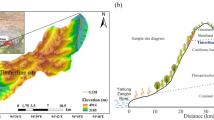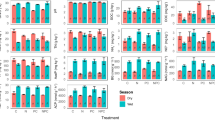Abstract.
To investigate the potential role of microbial community composition in soil carbon and nitrogen cycling, we transplanted soil cores between a grassland and a conifer ecosystem in the Sierra Nevada California and measured soil process rates (N-mineralization, nitrous oxide and carbondioxide flux, nitrification potential), soil water and temperature, and microbial community parameters (PLFA and substrate utilization profiles) over a 2 year period. Our goal was to assess whether microbial community composition could be related to soil process rates independent of soil temperature and water content. We performed multiple regression analyses using microbial community parameters and soil water and temperature as X-variables and soil process rates and inorganic N concentrations as Y-variables. We found that field soil temperature had the strongest relationship with CO2 production and soil NH4+ concentration, while microbial community characteristics correlated with N2O production, nitrification potential, gross N-mineralization, and soil NO3− concentration, independent of environmentalcontrollers. We observed a relationship between specific components of the microbial community (as determined by PLFA) and soil processes,particularly processes tightly linked to microbial phylogeny (e.g. nitrification). The most apparent change in microbial community composition in response to the 2 year transplant was a change in relative abundance of fungi (there was only one significant change in PLFA biomarkers for bacteria during 2 years). The relationship between microbial community composition and soil processes suggests that prediction of ecosystem response to environmental change may be improved by recognizing and accounting for changes in microbial community composition and physiological ecology.
Similar content being viewed by others
References
Anderson T.H. 1994. Physiological analysis of microbial communities in soil: applications and limitations. In: Ritz K., Dighton J. and Giller K.E. (eds), Beyond the Biomass. Wiley-Sayce, pp. 67–76.
T.-H. Anderson K.H. Domsch (1993) ArticleTitleThe metabolic quotient for CO2 (qCO2) as a specific activity parameter to assess the effects of environmental conditions, such as pH, on the microbial biomass of forest soils Soil Biol. Biochem. 25 393–395
Andren et al. (1999) ArticleTitleSoil organism influence on ecosystem-level processes- bypassing the ecological hierarchy? Appl. Soil Ecol. 11 177–188
Balser T.C. 2000. Linking Soil Microbial Communities and Ecosystem Functioning. Berkeley, Department of Soil Science. Doctoral Dissertation, University of California220 pp.
T.C. Balser J.W. Kirchner M.K. Firestone (2002a) ArticleTitleAnalytical and methodological variability in microbial community level physiological profiles Soil Sci. Soc. Am. J. 66 519–523 Occurrence Handle1:CAS:528:DC%2BD38XlvVCmtr8%3D
T.C. Balser A. Kinzig M.K. Firestone (2002b) Linking soil microbial communities and ecosystem functioning A. Kinzig S. Pacala D. Tilman (Eds) The Functional Consequences of Biodiversity: Empirical Progress and Theoretical Extensions Princeton University Press Princeton
D. Barraclough G. Puri (1995) ArticleTitleThe use of 15N pool dilution and enrichment to separate the heterotrophic and autotrophic pathways of nitrification Soil Biol. Biochem. 27 17–22 Occurrence Handle1:CAS:528:DyaK2MXjtFOisL0%3D
M. Begon J.L. Harper C.R. Townsend (1986) Ecology: Individuals, Populations and Communities Sinauer Associates Inc. SunderlandMassachusettes
D.A. Bossio K.M. Scow (1998) ArticleTitleImpacts of carbon and flooding on soil microbial communities: phospholipid fatty acid profiles and substrate utilization patterns Microbial Ecol. 35 265–278 Occurrence Handle1:CAS:528:DyaK1cXivFCms7c%3D
M.A. Cavigelli G.P. Robertson (2000) ArticleTitleThe functional significance of denitrifier community composition in a terrestrial ecosystem Ecology 81 1404–1414
R.A. Dahlgren J.L. Boettinger G.L. Huntington R.G. Amundson (1997) ArticleTitleSoil development along an elevational transect in the western Sierra NevedaCalifornia Geoderma 78 207–236
Federle T.W. 1986. Microbial distribution in soil–new techniques. In: Megusar F. and Gantar M. (eds), Microbial Ecology. Slovene Society for Microbiology, pp. 493–498.
Firestone M.K. and Davidson E.A. 1989. Microbiological basis of NO and N2O production and consumption in soil. In: Andreae M.O. and Schimel D. S. (eds), Exchange of Trace Gases Between terrestrial Ecosystems and the Atmosphere. John Wiley & Sons Ltd., pp. 7– 21.
J.L. Garland A.L. Mills (1991) ArticleTitleClassification and characterization of heterotrophic microbial communities on the basis of patterns of community-level sole-carbon-source utilization Appl. Environ. Microbiol. 57 2351–2359
J.L. Garland (1996) ArticleTitleAnalytical approaches to the characterization of samples of microbial communities using patterns of potential C source utilization Soil Biol. Biochem. 28 213–221 Occurrence Handle1:CAS:528:DyaK28XhtlClurs%3D
Hart S.C., Stark J.M., Davidson E.A. and Firestone M.K. 1994. Nitrogen mineralization, immobilization, and nitrification. In: (eds), Methods of Soil Analysis: Biochemical and Microbiological Properties. SSSA, Madison, WI, pp. 985–1018.
D.J. Herman P.D. Brooks M. Ashraf F. Azam R.L. Mulvaney (1995) ArticleTitleEvaluation of methods for nitrogen-15 analysis of inorganic nitrogen in soil extracts: II. Diffusion methods Commun. Soil Sci. Plant Anal. 26 1675–1685 Occurrence Handle1:CAS:528:DyaK2MXmsVSntL8%3D
T.C.J. Hill E.F. McPherson J.A. Harris P. Birch (1993) ArticleTitleMicrobial biomass estimated by phospholipid phosphate in soils with diverse microbial communities Soil Biol. Biochem. 25 1779–1786
Huenneke L. and Mooney H. 1989. In: Mooney H.A. and Huennecke L.F. (eds), Grassland Structure and Function: California Annual Grassland. Kluwer Academic Publishers, Dordrecht, The Netherlands.
L. Jackson R. Strauss M. Firestone J. Bartolome (1988) ArticleTitlePlant and Soil Nitrogen Dynamics in California Annual Grassland Plant and soil 110 9–17
H. Jenny S.P. Gessel F.T. Bingham (1949) ArticleTitleComparative study of decomposition rates of organic matter in temperate and tropical regions Soil Sci. 68 419–432 Occurrence Handle1:CAS:528:DyaG3cXitFSitA%3D%3D
A. Konopka L. Oliver R.F. Turco (1998) ArticleTitleThe use of carbon substrate utilization patterns in environmental and ecological microbiology Microbial Ecol. 35 103–115 Occurrence Handle1:CAS:528:DyaK1cXitFygurs%3D
O. Meyer (1994) Functional Groups of Microorganisms E.D. Schulze H.A. Mooney (Eds) Biodiversity and Ecosystem Function Springer Berlin, Heidelberg 67–96
R.L. Mulvaney (1996) Nitrogen – Inorganic Forms D.L. Sparks (Eds) Methods in Soil Analysis. Part 3, Chemical Methods Soil Science Society of America Madison, WI 1123–1200
Myrold D.D. 1998. Transformations of Nitrogen. Chapter 12. In: Sylvia D.M., Fuhrman J., Hartel P.G. and Zuberer D.A. (eds), Principles and Applications of Soil Microbiology. Prentice Hall, pp. 259–294.
H. Pedersen K.A. Dunkin M.K. Firestone (1999) ArticleTitleThe relative importance of autotrophic and heterotrophic nitrification in a conifer forest soil as measured by 15N tracer and pool dilution techniques Biogeochemistry 44 135–150
D.B. Ringelberg J.O. Stair J. Almeida R.J. Norby E.G. O’Neill D.C. White (1997) ArticleTitleConsequences of rising atmospheric carbon dioxide levels for the belowground microbiota associated with white oak J. Environ. Qual. 26 495–503 Occurrence Handle1:CAS:528:DyaK2sXitFOju70%3D
Schimel J.P. 2001. Biogeochemical models: implicit vs. explicit microbiology. In: Schulze E.D., Harrison S.P., Heimann M., Holland E.A., LLoyd J.J., Prentice I.C. and Schimel D. (eds), in Global Biogeochemical Cycles in the Climate System. Academic Press, pp. 177–183.
J. Schimel (1995) Ecosystem consequences of microbial diversity and community structure F.S.I. Chapin C. Koerner (Eds) Arctic and Alpine Biodiversity: Patterns, Causes and Ecosystem Consequences Springer Verlag New York 239–254
J.P. Schimel J. Gulledge (1998) ArticleTitleMicrobial Community Structure and Global Trace Gases Global Change Biol. 4 745–758
A.A. Schoenherr (1992) A Natural History of California University of California Press Berkeley
S. Selvin (1995) Practical Biostatstical Methods Duxbury Press Belmont CA
J.M. Stark S.C. Hart (1997) ArticleTitleHigh rates of nitrification and nitrate turnover in undisturbed coniferous forests Nature 385 61–64 Occurrence Handle1:CAS:528:DyaK2sXisl2qsg%3D%3D
S.E. Trumbore O.A. Chadwick R. Amundson (1996) ArticleTitleRapid exchange between soil carbon and atmospheric carbon dioxide driven by temperature change Science 272 393–396 Occurrence Handle1:CAS:528:DyaK28XisVehu7g%3D
J.R. Vestal D.C. White (1989) ArticleTitleLipid analysis in microbial ecology: quantitative approaches to the study of microbial communities BioScience 39 535–541 Occurrence Handle1:STN:280:DC%2BD3MnmtVOmtw%3D%3D Occurrence Handle11542183
Waldrop M.P. and Firestone M.K. 2004. Altered utilization patterns of young and old soil C by microorganisms caused by temperature shifts and N additions. Biogeochemistry, in press.
B.H. Walker W.L. Steffen (1999) The nature of Global Change B. Walker W. Steffen J. Canadell J. Ingram (Eds) The Terrestrial Biosphere and Global Change Cambridge University Press Cambridge 141–189
D.A. Wardle A. Ghani (1995) ArticleTitleWhy is the strength of relationships between pairs of methods for estimating soil microbial biomass often so variable? Soil Biol. Biochem. 27 821–828 Occurrence Handle1:CAS:528:DyaK2MXlsF2ms7s%3D
D.C. White W.M. Davis J.S. Nickels J.D. King R.J. Bobbie (1979) ArticleTitleDetermination of the sedimentary microbial biomass by extractable lipid phosphate Oecologia 40 51–62
S.G. Wilkinson (1988) Gram-negative bacteria C. Ratledge S.G. Wilkinson (Eds) Microbial Lipids Academic Press London 299–488
Zar J.H. 1984. Biostat. Anal.. Prentice Hall.
L. Zelles Q.Y. Bai T. Beck F. Beese (1992) ArticleTitleSignature fatty acids in phospholipids and lipopolysaccharides as indicators of microbial biomass and community structure in agricultural soils Soil Biol. Biochem. 24 317–323 Occurrence Handle1:CAS:528:DyaK38XkvV2nt74%3D
G.P. Zogg D.R. Zak D.B. Ringelberg N.W. MacDonald K.S. Pregitzer D.C. White (1997) ArticleTitleCompositional and functional shifts in microbial communities due to soil warming Soil Sci. Soc. Am. J. 61 475–481 Occurrence Handle1:CAS:528:DyaK2sXjtVyiurc%3D
Author information
Authors and Affiliations
Corresponding author
Rights and permissions
About this article
Cite this article
Balser, T., Firestone, M. Linking microbial community composition and soil processes in a California annual grassland and mixed-conifer forest. Biogeochemistry 73, 395–415 (2005). https://doi.org/10.1007/s10533-004-0372-y
Received:
Accepted:
Issue Date:
DOI: https://doi.org/10.1007/s10533-004-0372-y




